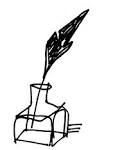 “Laziness has become the chief characteristic of journalism, displacing incompetence.”
“Laziness has become the chief characteristic of journalism, displacing incompetence.”
Kingsley Amis (quoted in Eric Felten, “Drinks Before Lunch with Kingsley Amis,” Weekly Standard, Nov. 5, 1995)
Terry Teachout on the arts in New York City
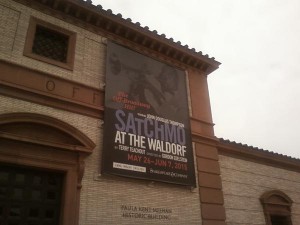 I flew out to Los Angeles yesterday morning for Tuesday’s sold-out preview of Satchmo at the Waldorf, which officially opens tonight at Beverly Hills’ Wallis Annenberg Center for the Performing Arts. We rehearsed in the afternoon, and when we were finished, Gordon Edelstein, John Douglas Thompson, and I tried to figure out how many performances John had given to date of Satchmo. Since he’s done it in Lenox, New Haven, Philadelphia, and New York, where Satchmo ran off Broadway for eighteen previews and 136 performances, our best guess is somewhere around three hundred times.
I flew out to Los Angeles yesterday morning for Tuesday’s sold-out preview of Satchmo at the Waldorf, which officially opens tonight at Beverly Hills’ Wallis Annenberg Center for the Performing Arts. We rehearsed in the afternoon, and when we were finished, Gordon Edelstein, John Douglas Thompson, and I tried to figure out how many performances John had given to date of Satchmo. Since he’s done it in Lenox, New Haven, Philadelphia, and New York, where Satchmo ran off Broadway for eighteen previews and 136 performances, our best guess is somewhere around three hundred times.
That’s a modest number compared to the herculean efforts of the elite corps of actors who’ve appeared in long-running Broadway shows for more than ten years. Still, it’s a not-inconsiderable achievement for John. Satchmo, after all, is a ninety-minute-long solo show in which he plays three sharply contrasting characters, never leaving the stage until the final curtain. He speaks some twelve thousand words at each performance, all of them committed to memory. That’s roughly the same number of words spoken by the title character in an uncut performance of Hamlet. Small wonder, then, that John, who is best known to the world as the outstanding American classical actor of his generation, has no trouble staying interested in my far more modest effort. While Satchmo is, to put it very mildly, no Hamlet, it’s complicated enough to hold his attention night after night.
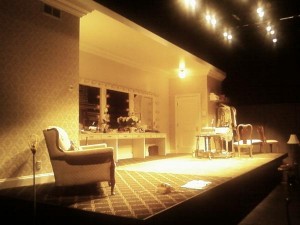 This is, by the way, the first time that I’ve seen Satchmo at the Waldorf, as well as the first time that I’ve taken part in a theatrical rehearsal of any kind, since the show closed off Broadway a year ago. Yet mere seconds after I walked into the theater, I felt as if I’d never been away, and I was as fascinated by the audience’s response to the play as I was when it was premiered by Dennis Neal in Orlando in 2011. The first nighters in Beverly Hills were quiet but attentive, bearing out something that hit me four years ago: some audiences experience Satchmo as a serious play with funny moments, others as a comedy that turns serious at the end. What’s more, I can always tell within a half-minute of the start of the show which kind of audience is in the theater—though not a second sooner.
This is, by the way, the first time that I’ve seen Satchmo at the Waldorf, as well as the first time that I’ve taken part in a theatrical rehearsal of any kind, since the show closed off Broadway a year ago. Yet mere seconds after I walked into the theater, I felt as if I’d never been away, and I was as fascinated by the audience’s response to the play as I was when it was premiered by Dennis Neal in Orlando in 2011. The first nighters in Beverly Hills were quiet but attentive, bearing out something that hit me four years ago: some audiences experience Satchmo as a serious play with funny moments, others as a comedy that turns serious at the end. What’s more, I can always tell within a half-minute of the start of the show which kind of audience is in the theater—though not a second sooner.
This is also the first time in ages that I’ve been in Los Angeles, which I found utterly mystifying when I came here in 2007:
“I kissed him, but I never knew him,” Ingrid Bergman is supposed to have said about Humphrey Bogart. That’s sort of how I feel about my first visit to Los Angeles: I spent three days there, but I still don’t quite know what I saw.
Los Angelenos, I gather, are sensitive to stereotypes, especially the ones they come up with themselves. Now I understand why. I saw enough of their home town to know that it would take me a lifetime to see the rest of it, and though one cliché turned out to be painfully self-evident—the traffic is really, truly awful—I can’t say I found any of the others useful. I’ve never seen a city that was more resistant to generalization, not even the one in which I live.
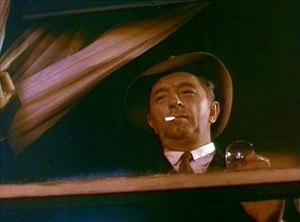 I still feel the same way, though I’d forgotten how completely alien Los Angeles seems to me—like another planet, really. You drive through a scruffy residential neighborhood, then suddenly there’s a movie studio on your immediate right. Alas, I won’t be here long enough to savor the strangeness, or even to see any of my friends. All I have time to do is rehearse the show, attend three performances, and make a couple of Satchmo-related appearances, after which I head straight back to New York to resume my day job, which always awaits me.
I still feel the same way, though I’d forgotten how completely alien Los Angeles seems to me—like another planet, really. You drive through a scruffy residential neighborhood, then suddenly there’s a movie studio on your immediate right. Alas, I won’t be here long enough to savor the strangeness, or even to see any of my friends. All I have time to do is rehearse the show, attend three performances, and make a couple of Satchmo-related appearances, after which I head straight back to New York to resume my day job, which always awaits me.
Two transcontinental flights in four days is well over my personal quota, which doubtless explains why I’m still feeling a bit fuzzy around the edges. I was awakened early today by a phone call from a polite but urgent-sounding young man who wanted to know whether I was on my way to an appointment of which I knew nothing whatsoever. I was still blurry from Tuesday’s travels, but within a few seconds I realized that someone had blundered, very possibly me. Finally my head cleared and I said, “Wait a minute. Who are you? Where are you? And who do you think I am?” It was, much to my relief, a wrong number. Even so, I was inches away from throwing on my clothes and running to the theater. That’s what too much travel in too little time does to me. Or maybe it’s just Los Angeles.
 I’ve never had what it is now the custom to call a “bucket list.” I’m pretty sure this is because I’m not one to think in terms of long-range goals. Don’t be bored has always been my Prime Directive, and when you look at life that way, you tend not to plan very far ahead. I don’t know whether that’s a characteristic bias of the journalist, who jumps from story to story, or a point of view more specific to me. Whatever the reason, it’s the way I operate: I take things as they come.
I’ve never had what it is now the custom to call a “bucket list.” I’m pretty sure this is because I’m not one to think in terms of long-range goals. Don’t be bored has always been my Prime Directive, and when you look at life that way, you tend not to plan very far ahead. I don’t know whether that’s a characteristic bias of the journalist, who jumps from story to story, or a point of view more specific to me. Whatever the reason, it’s the way I operate: I take things as they come.
After I wrote this posting, though, I asked myself whether there really were any particular things I wanted to do before I died, and pretty soon I had my very own bucket list. Here it is:
• Visit the Grand Canyon
• Make one last concerted attempt to read all of Charles Dickens’ major novels
• Own an etching by Giorgio Morandi
• Go to England (amazingly, I never have)
• Direct a play by someone else
• Take a river cruise
• Review a completely satisfying revival of Joe Orton’s What the Butler Saw
• Drive from coast to coast without an itinerary, preferably in an RV
• Teach more
If that strikes you as a pretty modest list, I can only agree. But, then, my life until now has been so full of extraordinary occurrences—most of them utterly unexpected, at least by me—that I must confess to being, if not exactly content, then at least reasonably happy with the way things have gone so far. Small-town boys, after all, are raised to have realistic expectations, and while Mrs. T thinks that this attitude may have inhibited me in the past, my own feeling is that it’s served me well. Certainly it’s characteristic of me that all of the items on the above list are at least doable, and that most of them are in fact perfectly plausible…about which more, I hope, later!
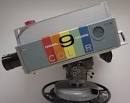 A 1973 telecast of the opening scene of Rodeo, danced by American Ballet Theatre, followed by an interview with Agnes de Mille. The choreography is by de Mille and the score is by Aaron Copland:
A 1973 telecast of the opening scene of Rodeo, danced by American Ballet Theatre, followed by an interview with Agnes de Mille. The choreography is by de Mille and the score is by Aaron Copland:
(This is the latest in a series of arts-related videos that appear in this space each Monday and Wednesday.)
 “All schizophrenia patients are mad, and none are sane. Their behaviour is incomprehensible. It tells us nothing about what they do in the rest of their lives, gives no insight into the human condition and has no lesson for sane people except how sane they are. There’s nothing profound about it. Schizophrenics aren’t clever or wise or witty—they may make some very odd remarks but that’s because they’re mad, and there’s nothing to be got out of what they say. When they laugh at things the rest of us don’t think are funny, like the death of a parent, they’re not being penetrating, and on other occasions they’re not wryly amused at the simplicity and stupidity of the psychiatrist, however well justified that might be in many cases. They’re laughing because they’re mad, too mad to be able to tell what’s funny any more. The rewards for being sane may not be very many but knowing what’s funny is one of them.”
“All schizophrenia patients are mad, and none are sane. Their behaviour is incomprehensible. It tells us nothing about what they do in the rest of their lives, gives no insight into the human condition and has no lesson for sane people except how sane they are. There’s nothing profound about it. Schizophrenics aren’t clever or wise or witty—they may make some very odd remarks but that’s because they’re mad, and there’s nothing to be got out of what they say. When they laugh at things the rest of us don’t think are funny, like the death of a parent, they’re not being penetrating, and on other occasions they’re not wryly amused at the simplicity and stupidity of the psychiatrist, however well justified that might be in many cases. They’re laughing because they’re mad, too mad to be able to tell what’s funny any more. The rewards for being sane may not be very many but knowing what’s funny is one of them.”
Kingsley Amis, Stanley and the Women
I got a call yesterday from a fact checker at The New Yorker who wanted to know whether H.L. Mencken actually sent the following form letter to angry correspondents: Dear Sir or Madam: You may or may not be right. Would that he had–it’s a great story–but in the decade I spent researching and writing The Skeptic, I found not the slightest bit of evidence that he ever sent such a letter to anyone.
What tickled me about this call was that it made me feel like a Grand Old Man. The nice young fellow from The New Yorker asked, “Is this Terry Teachout, author of The Skeptic?” in tones that made me wonder whether I’d just heard a preview of my obituary….
Read the whole thing here.
 “New York is a terrifying city but hectically beautiful in many ways. The kindness and welcome are overwhelming, but there is too much money, food and drink and too much respect for success, while endeavour and failure are just ignored, or swept away as if there wasn’t any time or place for them.”
“New York is a terrifying city but hectically beautiful in many ways. The kindness and welcome are overwhelming, but there is too much money, food and drink and too much respect for success, while endeavour and failure are just ignored, or swept away as if there wasn’t any time or place for them.”
John Gielgud, letter to Christopher Fry (November 1950)
 The invaluable Maria Popova has drawn my attention to a blog and book devoted to photographs and lists taken and drawn up by people in answer to the following question: If your house was burning, what would you take with you?
The invaluable Maria Popova has drawn my attention to a blog and book devoted to photographs and lists taken and drawn up by people in answer to the following question: If your house was burning, what would you take with you?
While this is a marvelous question, I soon realized that my own answer to it wouldn’t be nearly as revealing as those of most other people. Yes, my apartment contains a goodly amount of stuff, but my feelings about it are far more detached than you’d expect from a person who reveres the past as much as I do.
As I observed in this space eleven years ago:
I’ve always been oddly unsentimental about objects, and I don’t know why. Perhaps it’s simply a manifestation of a preference that I mentioned a few months ago apropos of the rise of pay-per-song Web sites and the resulting decline of the record as art object: “I’m old-fashioned—but my attachment is to essences, not embodiments.” Or maybe it has more to do with the fact that I’ve spent the past quarter-century moving from one small apartment to another (two in Kansas City, one in Illinois, four in the New York area), a practice that tends to inhibit the accumulation of superfluous stuff.
Whatever the reason, I haven’t kept many souvenirs of my past life. Nearly all those dating from my childhood and adolescence—my old Roth violin, my high-school yearbooks, a scraggly pair of stuffed cats named Russell and Louise—are at my mother’s house in Smalltown, U.S.A., which is where I expect they’ll stay. Beyond that, next to nothing remains. I’ve never saved the manuscripts of my books, for instance, and I got rid of all my tattered old clippings after putting together A Terry Teachout Reader. I sold two-thirds of my library when I moved to my present apartment, mainly in order to have room to hang the art I was starting to collect. I don’t keep programs from the performances I review, nor do I have any photograph albums (in fact, I don’t even own a camera). The only pictures I have on display are the ones of my parents, Our Girl in Chicago, and my old friend Nancy LaMott that are on my desk, plus a snapshot taken in an old-time photo booth immediately after I completed my first roller-coaster ride. A mottled, surf-pocked stone from the shore of Isle au Haut, the Maine island to which I traveled last fall in search of the spot that Fairfield Porter portrayed in a lithograph I own, rests atop my incoming mail. One of my paintings was done by a friend. And outside of a few inscribed books and a bare handful of unsorted photos crammed randomly in a drawer, that’s pretty much it. Except for these few relics, I live almost entirely in the present, surrounded by books, CDs, and the art on my walls.
 What was true in 2004 is no less true today, though I now have a few more snapshots on my desk and a lot more art on the walls. It’s true that I’ve acquired a fair number of additional souvenirs, most of them having to do with the various productions of my play and opera libretti, but none of them are on display. And while much thought went into choosing the contents of the Manhattan apartment that Mrs. T and I share, which is comfortable and (we think) pleasant to behold, it really is what Le Corbusier called a machine for living—and writing. Yes, I love my miniature stereo and her elegant toaster-oven, but I don’t feel the least bit sentimental about them. I enjoy looking at them and they do what they’re supposed to do, and there’s an end to it.
What was true in 2004 is no less true today, though I now have a few more snapshots on my desk and a lot more art on the walls. It’s true that I’ve acquired a fair number of additional souvenirs, most of them having to do with the various productions of my play and opera libretti, but none of them are on display. And while much thought went into choosing the contents of the Manhattan apartment that Mrs. T and I share, which is comfortable and (we think) pleasant to behold, it really is what Le Corbusier called a machine for living—and writing. Yes, I love my miniature stereo and her elegant toaster-oven, but I don’t feel the least bit sentimental about them. I enjoy looking at them and they do what they’re supposed to do, and there’s an end to it.
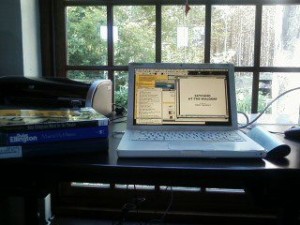 So…what would I grab if the sirens started to shriek? It goes without saying that Mrs. T would be my first and only consideration under such horrific circumstances, but assuming that she happened to be elsewhere, I’d stuff my MacBook into my black shoulder bag (in which I already keep my wallet, passport, and cellphone) before thinking of anything else. In addition to being the tool that I use to do my work and communicate with the world, it contains all of my current and past writings and seventeen days’ worth of carefully chosen music. I could replace any of the books and CDs on my shelves with relative ease, but losing my MacBook would be like losing a thumb.
So…what would I grab if the sirens started to shriek? It goes without saying that Mrs. T would be my first and only consideration under such horrific circumstances, but assuming that she happened to be elsewhere, I’d stuff my MacBook into my black shoulder bag (in which I already keep my wallet, passport, and cellphone) before thinking of anything else. In addition to being the tool that I use to do my work and communicate with the world, it contains all of my current and past writings and seventeen days’ worth of carefully chosen music. I could replace any of the books and CDs on my shelves with relative ease, but losing my MacBook would be like losing a thumb.
What next? Any indispensable souvenirs of the past? Probably not. The only one that really matters is my wedding ring, which I already carry with me on a finger. Everything else is expendable—except for the works of art that hang on the walls of our apartment. While most of them are prints of various kinds that exist in multiple copies, nearly all of them would be difficult to replace, and Mrs. T and I also own a half-dozen paintings and drawings that are, quite literally, irreplaceable.
Of the three dozen or so pieces currently hanging in the Teachout Museum, the one that means the most to me personally, Max Beerbohm’s 1913 caricature of Percy Grainger, is also the rarest, and it has the further advantage of being small enough to tuck under one arm. I expect I’d snatch it up first. And what else? I’ve been giving that question some serious thought. Our Marsden Hartley lithograph, which we chose together in 2006, is a genuine rarity, but it’s also slightly too large to carry in nerve-racked haste. No less rare is “Storm King,” our recently acquired Childe Hassam lithotint, and it’s also fairly small, making it a more logical candidate for preservation. I wouldn’t grab “Storm King,” though, until I’d seen to the two smallest pieces in the Teachout Museum, both of which would fit easily into my shoulder bag and both of which have special meaning for us.
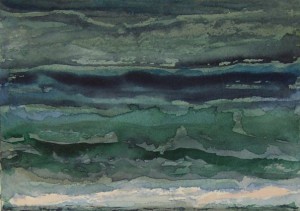 The first work of art that the two of us ever bought together, mere months before we got married, was “Breaking Light,” a 2003 watercolor by Jane Wilson, a much-admired New York painter who died earlier this year. We saw it for the first time on the wall of DC Moore Gallery four years after Wilson painted it. Entranced by its delicate, near-abstract subtleties, we bought it on the spot—the first and last time that either of us has ever done such a thing—and hung it that afternoon. Since then, I’ve made a special point of looking at “Breaking Light” whenever I’m in our New York apartment. Not only is it a beautiful and precious objet d’art, but it is also a visible symbol of the midlife union that has changed my life beyond recognition.
The first work of art that the two of us ever bought together, mere months before we got married, was “Breaking Light,” a 2003 watercolor by Jane Wilson, a much-admired New York painter who died earlier this year. We saw it for the first time on the wall of DC Moore Gallery four years after Wilson painted it. Entranced by its delicate, near-abstract subtleties, we bought it on the spot—the first and last time that either of us has ever done such a thing—and hung it that afternoon. Since then, I’ve made a special point of looking at “Breaking Light” whenever I’m in our New York apartment. Not only is it a beautiful and precious objet d’art, but it is also a visible symbol of the midlife union that has changed my life beyond recognition.
The other piece that I’d rush to save is “View from My Studio,” a 1966 fired ceramic tile by Nell Blaine that I bought a few years before meeting Mrs. T. Blaine, who died in 1996, is another insufficiently known New York painter whose style speaks powerfully to me, so much so that the first work of art I ever bought was one of her floral lithographs, which I purchased in 2003. A year or so later I saw “View from My Studio” on eBay, back in the far-off days when it was still possible to stumble across fine-art bargains on that once-essential site. Apparently I was the only user of eBay who knew who Blaine was, for I placed the only bid on “View from My Studio,” a sum in the low three figures, and have treasured it ever since. The view referred to in the title, from the window of the studio in her Riverside Drive apartment, is not entirely unlike what I used to see whenever I looked out the windows of my own apartment on New York’s Upper West Side, which Mrs. T and I shared until we decided to move to Upper Manhattan a few years ago.
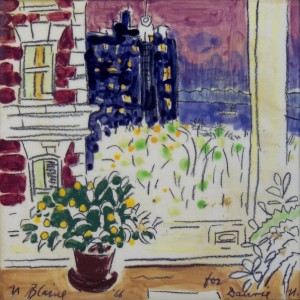 Not surprisingly, Mrs. T fell in love with “View from My Studio” at first sight, and when we decided to give the guests at our wedding a custom-pressed CD called Autumn in New York: A Wedding Album (Mostly by Friends, Present and Absent), we opted to put a reproduction of the tile on the cover of the CD booklet.
Not surprisingly, Mrs. T fell in love with “View from My Studio” at first sight, and when we decided to give the guests at our wedding a custom-pressed CD called Autumn in New York: A Wedding Album (Mostly by Friends, Present and Absent), we opted to put a reproduction of the tile on the cover of the CD booklet.
So there you have it: “View from My Studio,” “Breaking Light,” and my MacBook in my shoulder bag, with Max Beerbohm under one arm and (if possible) Childe Hassam under the other. These are the fragments that I’ll shore against my ruin should New York’s Bravest come calling—these and my memories, which are infinitely more valuable than any painting, however beautiful.
Evelyn Waugh said it:
My theme is memory, that winged host that soared about me one grey morning of war-time. These memories, which are my life—for we possess nothing certainly except the past—were always with me. Like the pigeons of St. Mark’s, they were everywhere, under my feet, singly, in pairs, in little honey-voiced congregations, nodding, strutting, winking, rolling the tender feathers of their necks, perching sometimes, if I stood still, on my shoulder or pecking a broken biscuit from between my lips; until, suddenly, the noon gun boomed and in a moment, with a flutter and sweep of wings, the pavement was bare and the whole sky above dark with a tumult of fowl.
He, too, knew that no matter how many beautiful things you possess, a life without memories is no life at all.
| M | T | W | T | F | S | S |
|---|---|---|---|---|---|---|
| 1 | 2 | 3 | 4 | |||
| 5 | 6 | 7 | 8 | 9 | 10 | 11 |
| 12 | 13 | 14 | 15 | 16 | 17 | 18 |
| 19 | 20 | 21 | 22 | 23 | 24 | 25 |
| 26 | 27 | 28 | 29 | 30 | 31 | |
An ArtsJournal Blog